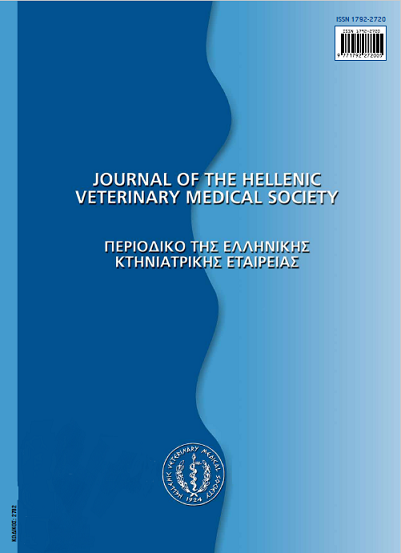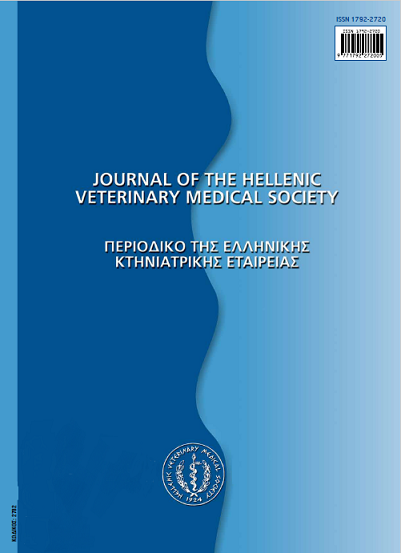Βαριάς μορφής εστιακή συμπιεστική μυελοπάθεια από αραχνοειδή ψευδοκΰστη σε σκΰλο φυλής Rottweiler

Περίληψη
Το περιστατικό που περιγράφεται αφορούσε σε σκΰλο φυλής Rottweiler, ηλικίας τεσσάρων ετών, ο οποίος προσκομίστηκεστην Κλινική των Ζώων Συντροφιάς, επειδή εμφάνιζε για διάστημα 4 μηνών μυελική αταξία και τετραπάρεση που επιδεινώνονταν προοδευτικά (αυχενικό σύνδρομο). Στη νευρολογική εξέταση ο σκύλος εμφάνιζε σπαστική τετραπληγια, χωρίς άλλα ευρήματα από τη γενική κλινική εξέταση και τις αρχικές εργαστηριακές εξετάσεις (αιματολογική, βιοχημική του OQOV καιακτινολογική εξέταση της αυχενικής μοίρας της σπονδυλικής στήλης). Στη μυελογραφια διαπιστώθηκε αδυναμία προώθησης του σκιαγραφικού μέσου μετά από το επίπεδο του 5ου αυχενικού σπονδύλου και στη μαγνητική τομογραφία παρατηρήθηκε ενδοσκληριδια-εξωμυελική συμπίεση και διόγκωση του νωτιαίου μυελού στο επίπεδο του 5ου και 6ου μεσοσπονδυλίου διαστήματοςαπό αραχνοειδή ψευδοκύστη και εστιακή μυελοπάθεια που αφορούσε στα νευροτόμια Α5-Α6. Στην ιστοπαθολογική εξέταση διαπιστώθηκε διάχυτη απομυελινωση της αυχενικής μοίρας του νωτιαίου μυελού, η οποία ήταν ιδιαιτέρως έντονου βαθμού στα νευροτόμια Α5-Α6, αλλά επεκτεινόταν και σε απομακρυσμένα από την αλλοίωση σημεία, όπως ο προμήκης μυελός και η θωρακική μοίρα του νωτιαίου μυελού, γεγονός το οποίο ήταν και το πλέον ενδιαφέρον εύρημα.
Λεπτομέρειες άρθρου
- Πώς να δημιουργήσετε Αναφορές
-
POLIZOPOULOU (Ζ.Σ. ΠΟΛΥΖΟΠΟΥΛΟΥ) Z. S., SOUFTAS (Β.Δ. ΣΟΥΦΤΑΣ) V. D., BRELLOU (Γ. ΜΠΡΕΛΛΟΥ) G., PATSIKAS (Μ.Ν. ΠΑΤΣΙΚΑΣ) M. N., SOUBASIS (Ν. ΣΟΥΜΠΑΣΗΣ) Ν., & KOUTINAS (Α.Φ. ΚΟΥΤΙΝΑΣ) A. F. (2017). Βαριάς μορφής εστιακή συμπιεστική μυελοπάθεια από αραχνοειδή ψευδοκΰστη σε σκΰλο φυλής Rottweiler. Περιοδικό της Ελληνικής Κτηνιατρικής Εταιρείας, 61(1), 23–28. https://doi.org/10.12681/jhvms.14872
- Τεύχος
- Τόμ. 61 Αρ. 1 (2010)
- Ενότητα
- Case Report
Οι συγγραφείς των άρθρων που δημοσιεύονται στο περιοδικό διατηρούν τα δικαιώματα πνευματικής ιδιοκτησίας επί των άρθρων τους, δίνοντας στο περιοδικό το δικαίωμα της πρώτης δημοσίευσης.
Άρθρα που δημοσιεύονται στο περιοδικό διατίθενται με άδεια Creative Commons 4.0 Non Commercial και σύμφωνα με την άδεια μπορούν να χρησιμοποιούνται ελεύθερα, με αναφορά στο/στη συγγραφέα και στην πρώτη δημοσίευση για μη κερδοσκοπικούς σκοπούς.
Οι συγγραφείς μπορούν να καταθέσουν το άρθρο σε ιδρυματικό ή άλλο αποθετήριο ή/και να το δημοσιεύσουν σε άλλη έκδοση, με υποχρεωτική την αναφορά πρώτης δημοσίευσης στο J Hellenic Vet Med Soc
Οι συγγραφείς ενθαρρύνονται να καταθέσουν σε αποθετήριο ή να δημοσιεύσουν την εργασία τους στο διαδίκτυο πριν ή κατά τη διαδικασία υποβολής και αξιολόγησής της.











